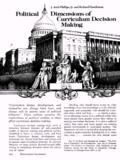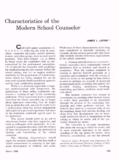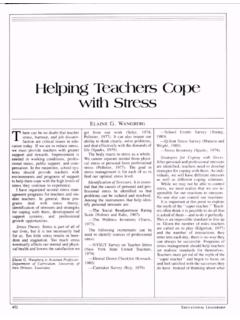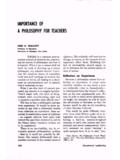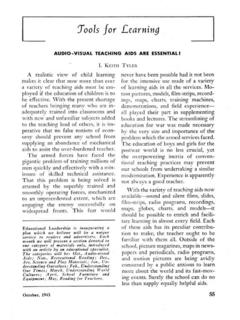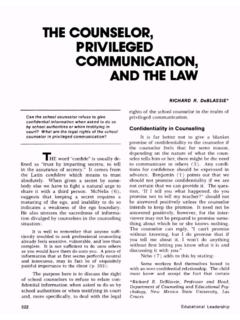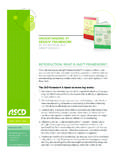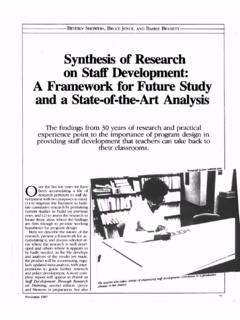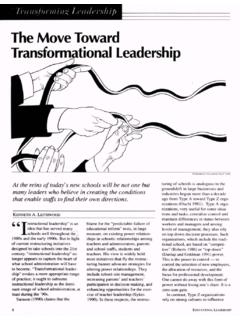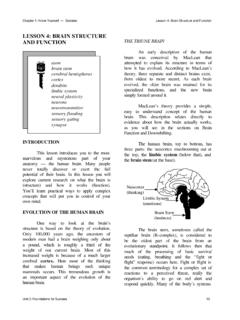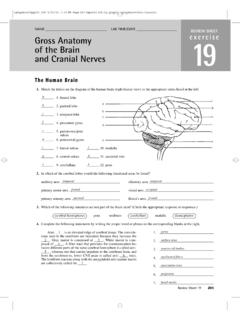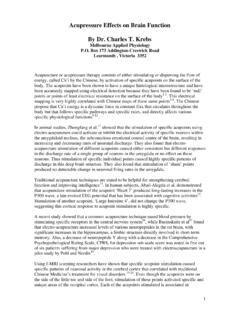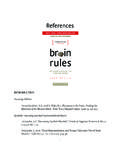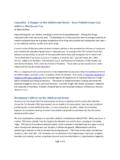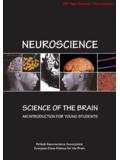Transcription of Educational Implications of Recent Brain Research
1 New knowledge about functioning of the human Brain may enable schools to teach thinking more effectively. We asked four authorities to list: Educational Implications of Recent Brain Research Educational LEADERSHIP. ROBERT SYLWESTER. he Brain is the most magnificent needed for new cognitive functions, the two-year period, generally earlier T three pounds of matter in the universe. What we now know about the human Brain and what we'll such as speaking and reading; and (2) longer periods of practically no growth when the new functions are for girls and later for boys. During the 10-12+ growth spurt, female Brain growth is about three times that discover in the years ahead may well probably integrated into the total of males, and the situation is re transform formal education.
2 Cognitive system. This sequence of versed, favoring males, during the Unfortunately, the present social growth and dormancy occurs fre 14-16+ Brain growth period. i science/behavioral orientation of our quently in nature (for instance, tree profession creates a problem. Educa growth ). pstein reports other discoveries, tion majors tend to shy away from biology and chemistry courses, and most practicing educators don't read Brain Research . Further, Brain re Three periods of Brain growth occur during the school years. Most normal children experience a rapid 5 to 10 percent Brain weight increase E but for now it's probably enough just to consider the Educational Implications of these '. searchers typically don't focus on between the ages of 2 -4, 6-8.
3 10-12 + . three statements: education Implications or publish in and 14-16 + . In normal children this 1. Brain growth occurs during six education journals. The result is an growth spurt occurs during a period of the 12 school grades. About every education profession largely unaware of about six months sometime during ten days, on the average, someone of significant Brain Research , ripe for blind acceptance of generalizations and fads. Educational change generally takes a generation or longer as new infor mation is disseminated across the pro fession. Will parents allow us that much time if new Brain discoveries clearly show that Educational adapta tions will affect the quality of their children's education? Let's consider one example.
4 The final pound 01 the adult three-pound Brain develops between the ages of 2 and 16. This growth involves the development of more remote axon/. dendrite extensions throughout the neural network, and the formation of an insulating layer (myelin) around axons. This final pound of growth enhances the Brain 's efficiency and capability. Epstein 1 has discovered that this growth does not occur con tinuously, but rather in sequences of (1) short periods of rapid growth that create the neural networks Robert Sylwesler is Professor of Educa tion. University of Oregon, Eugene. OCTOBER 1981. " Brain growth occurs during six of the 12. school grades. About every ten days, on the average, someone in each classroom begins or ends a Brain growth spurt.
5 ". in each classroom begins or ends a Brain growth spurt. 2. About one-fourth of the stu dents will go through a growth spurt during the summer when schools are closed. 3. Significant normative sex differ ences exist in Brain growth patterns. What do these discoveries imply for individualization, year-round schools, grade acceleration/failure policies, and homogeneous class rooms? It's still too early for schools to effect immediate organizational, cur- ricular, and instructional changes. For example, we don't yet know how to determine when a given child's Brain growth is beginning and ending, nor do we have the complete picture of where growth occurs in the Brain , nor are we certain of the appropriate instructional strategies for growth and plateau periods.
6 Other areas of Brain Research also have much Educational significance Research focusing on right/left hemi sphere lateralization and integration, the angular gyrus, endorphin mole cules, the cerebellum, memory, hy- peractivity, and attention. ut can we afford to wait until B all problems are solved before we begin to study the educa tional issues implicit in this Research ? When mass media begin to report dis coveries, parents will expect us to respond. The title of Restak's book, The Brain : The Last Frontier,'2 succinctly describes the challenges educators face. Look at where heart Research and space exploration were ten years ago and then think about where Brain Research might be in ten If we're going to respond to the chal- EDUCATIONAI.
7 LEADERSHIP. lenge when it arrives full blown, we as one and the student to behave as need to start now on a number of one. fronts, including the following: Educators need to work with scien Preservice and Inservice Educa tists to develop accurate and appro tion: I t's a rare teacher education priate definitions, explanations, mod student who has a respectable back els, and metaphors of the Brain that ground in cell biology, biochemistry, teachers and students can easily un and neuroscience; and it's a rare in- derstand and use during this period service program that systematically when scientific information about the introduces relevant Brain Research to Brain is limited in the schools. its teaching and administrative start. The Educational and Medical Pro Even though the social science/beha fessions: Recent Brain discoveries vioral orientation of our profession suggest that the Educational and med will probably continue, we need to ical professions might have a lot prepare educators to understand the more in common by the end of the Brain that really defines our profes decade than they do now.
8 Research sion. We ought to adapt our pre- in chemical interventions (such as in service and inservice programs so hyperactivity) certainly affects both that we can become better acquainted professions, as does Research in nu with our own brains, and we ought to trition, stress, endorphins, biofeed- introduce our students to theirs. back, and Brain growth patterns. Models and Metaphors: Miller4 Brain discoveries may encourage suggests that we have never under us to move away from our traditional stood any part of our body until we proactive/group/normative approach recreated it metaphorically and tech to our students toward the more re- nologically outside our body. For ex active/individual/diagnostk approach ample, the invention of the water the medical profession uses.
9 Epstein's pump led to a clearer understanding Brain growth Research and the in of the heart. creasing use of Individual Education Since schools traffic heavily in Plans in our profession suggest some metaphors, it might be useful to in movement in that direction. School troduce Brain studies into the school psychologists, speech pathologists, through the development and use of and others who work with student appropriate models and metaphors Brain excess/deficit problems already that define the Brain and its functions function much as medical doctors do for educators with a limited scientific scheduling students individually, background. focusing on diagnosis, prescribing The computer (a swift idiot) has treatments that others carry out, and become the popular metaphor of the so on.
10 Further, Educational specialists Brain . The metaphor is flawed, and aides, Educational malpractice though, which can lead to misconcep suits, voucher systems, and teacher tions about ways students process internships all have an interesting information, respond to instruction, medical ring. and learn. If people perceive the Oddly enough, while the schools Brain to be little more than a com are nudging toward the medical puter, they will expect it to function model, the medical movement toward OCTOBER 1981. holistic medicine, preventive medi cine, group medical practice, and childbirth and weight reduction classes all signal a medical interest in educating the patient. Where all this will lead is unknown but it does suggest that the two pro fessions should begin serious conver sations.
